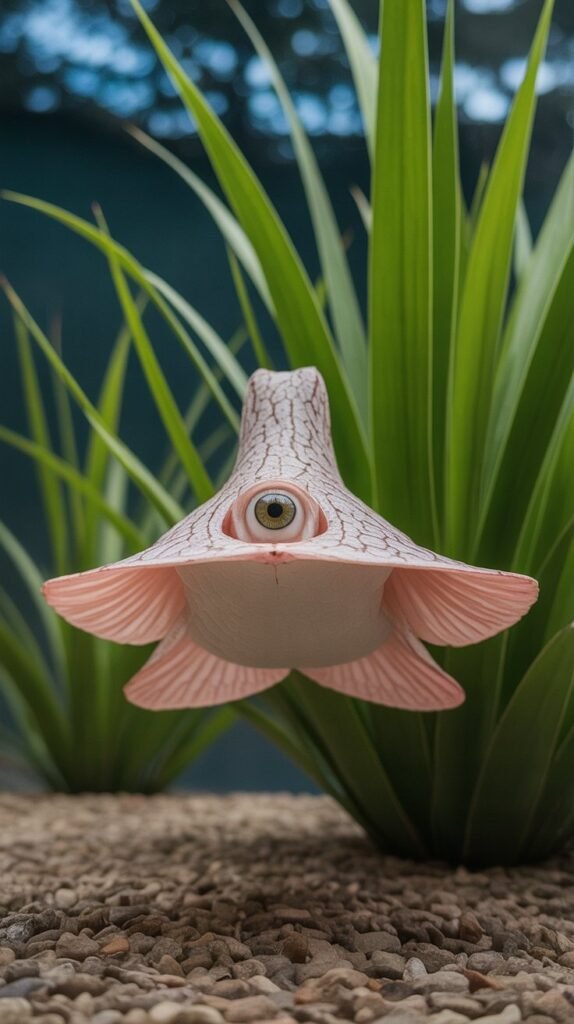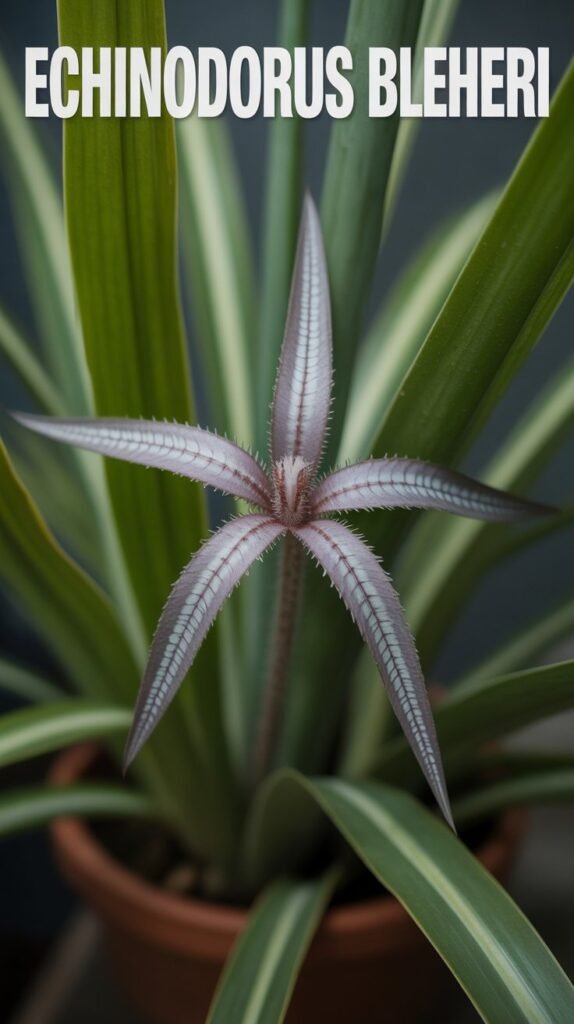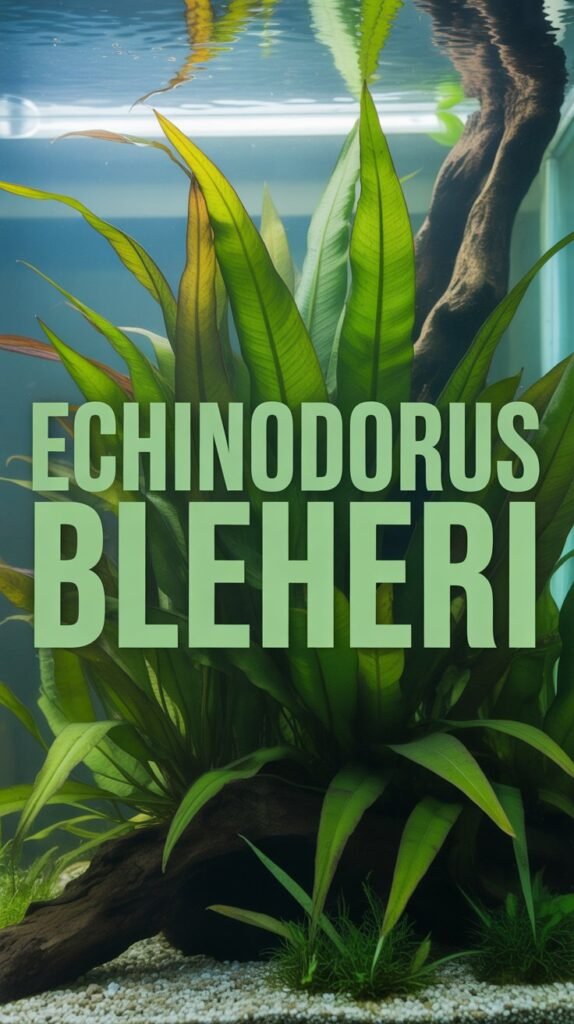Among all aquarium plants, few are as iconic, resilient, and visually captivating as the Echinodorus bleheri, commonly known as the Amazon Sword Plant. This lush, green aquatic beauty is a favorite among aquarists for its versatility, easy care, and ability to create a stunning centerpiece in both beginner and advanced aquarium setups.
In this comprehensive guide, we’ll explore everything you need to know about Echinodorus bleheri — from its origin and characteristics to planting, propagation, maintenance, and tank compatibility — so you can create a thriving underwater garden that mirrors the natural Amazonian environment.
What Is Echinodorus Bleheri?
Echinodorus bleheri, also known as the Amazon Sword or Echinodorus paniculatus, is a freshwater aquatic plant native to South America, particularly in regions of the Amazon Basin. It belongs to the Alismataceae family, which includes various sword plants commonly found in tropical wetlands and shallow riverbeds.
This plant is well-known for its large, sword-shaped leaves, which can grow up to 20 inches long under ideal conditions. Because of its impressive size and lush green appearance, it serves as a stunning background or centerpiece plant in freshwater aquariums.

Scientific Classification
- Scientific Name: Echinodorus bleheri
- Common Names: Amazon Sword, Broadleaf Amazon Sword, Echinodorus Paniculatus
- Family: Alismataceae
- Origin: South America (Brazil, Peru, Colombia)
- Type: Rosette plant
- Growth Form: Submerged aquatic plant
Natural Habitat
In the wild, Echinodorus bleheri thrives in the slow-moving rivers, marshes, and flooded forests of the Amazon Basin. It grows partially or fully submerged, depending on seasonal water levels. During floods, it becomes fully aquatic; in drier seasons, it can grow emersed, with its leaves extending above the water’s surface.
These natural habitats are:
- Warm (24–30°C)
- Rich in nutrients
- Gently lit by filtered sunlight
- Full of decaying organic matter that enriches the substrate
Replicating these conditions in your aquarium helps this plant grow vigorously and maintain its vibrant green color.
Physical Description of Echinodorus Bleheri
The Amazon Sword Plant is easily recognizable due to its bold, lush appearance. Its beauty lies in its simplicity and adaptability.
Key Characteristics:
- Leaves: Broad, elongated, and sword-shaped. They are bright to dark green depending on lighting and nutrient levels.
- Height: Typically grows between 12 to 20 inches tall in aquariums but can reach up to 24 inches in optimal conditions.
- Growth Pattern: Forms a dense rosette from which leaves radiate outward.
- Roots: Strong and deep-rooting system, capable of absorbing nutrients directly from the substrate.
- Lifespan: Can live for many years with proper care.
Because of its height, this plant is ideal for background placement or as a focal point in large tanks.
Ideal Tank Conditions for Echinodorus Bleheri
Creating the right environment ensures the Amazon Sword flourishes and maintains its healthy green color. Below are the ideal parameters:
| Parameter | Ideal Range |
|---|---|
| Temperature | 22–28°C (72–82°F) |
| pH Level | 6.5–7.5 |
| Water Hardness | 3–8 dKH |
| Lighting | Moderate to high |
| Substrate | Nutrient-rich soil or gravel |
| Tank Size | Minimum 20 gallons (preferably 30+) |
While it’s a hardy plant, the Echinodorus bleheri grows best in stable, warm conditions with consistent lighting and nutrient support.

Lighting Requirements
Light is one of the most critical factors for this plant’s success. The Amazon Sword can adapt to a wide range of light intensities, but moderate to high lighting promotes stronger growth and deeper green coloration.
- Low light: Slower growth, paler leaves
- Medium light: Balanced growth and healthy color
- High light: Vigorous growth but may require CO₂ and nutrient supplementation
Provide about 8–10 hours of light per day, ideally using full-spectrum LED lights that mimic natural sunlight.
Substrate and Root Nutrition
Echinodorus bleheri is primarily a root feeder, meaning it absorbs most of its nutrients from the substrate rather than the water column.
Best Substrates:
- Aquarium soil or nutrient-rich gravel
- Root tabs if using inert substrates like sand
- Avoid coarse gravel that can damage roots
For maximum health, enrich the substrate with iron and trace minerals. Root tabs every 4–6 weeks can significantly boost growth and leaf color.
Water Parameters and Maintenance
This plant is remarkably adaptable, which makes it beginner-friendly. Still, it prefers clean, stable conditions.
Recommended Maintenance Routine:
- Perform weekly water changes (20–30%)
- Maintain stable pH levels around neutral
- Avoid excessive algae by preventing nutrient imbalances
- Regularly remove damaged or yellowing leaves
Amazon Swords can tolerate a range of hardness levels, but slightly soft to moderate water helps maintain lush growth.
Fertilization and CO₂
While not mandatory, fertilization enhances the appearance and vitality of Echinodorus bleheri.
1. Root Fertilizers (Essential)
Use root tabs rich in iron, potassium, and trace minerals for strong root and leaf development.
2. Liquid Fertilizers (Optional)
Supplement with liquid fertilizers for macro and micronutrients like nitrogen, phosphorus, and potassium.
3. CO₂ Injection
CO₂ is not required, but adding it can result in:
- Faster growth
- Larger leaves
- Deeper green coloration
If using high-intensity lighting, CO₂ injection helps prevent algae by balancing nutrient uptake.
Planting Echinodorus Bleheri
Proper planting ensures strong root establishment and healthy long-term growth.
Steps to Plant:
- Rinse the plant gently to remove any debris or old substrate.
- Trim damaged roots or leaves.
- Make a small hole in the substrate using your fingers or planting tool.
- Place the plant’s roots into the substrate, covering them gently.
- Do not bury the crown (the point where roots meet leaves), as this may cause rot.
- Anchor the plant using a small rock if necessary until roots establish.
Within a few weeks, you’ll see new leaves emerging, signaling successful adaptation.
Propagation of Echinodorus Bleheri

Propagation is one of the most rewarding parts of growing this plant. The Amazon Sword propagates primarily through runners or flower stalks.
1. Runner Propagation
- Mature plants send out stolons (horizontal runners).
- Tiny plantlets develop along these runners.
- Wait until plantlets have 3–4 leaves and visible roots before separating.
- Replant them in the substrate to grow new plants.
2. Flower Stalk Propagation
In open or shallow tanks, Echinodorus bleheri may produce emergent flower stalks with plantlets.
- Cut the stalk after plantlets form.
- Float or plant them in another tank.
With time and care, you can easily grow multiple Amazon Swords from a single mother plant.
Pruning and Growth Control
Echinodorus bleheri can grow large and overshadow smaller plants, so regular pruning is necessary.
Pruning Tips:
- Remove yellow, melted, or damaged leaves near the base.
- Cut older leaves to promote new growth.
- Avoid cutting too many leaves at once to prevent shock.
- Thin out dense clusters to improve light penetration.
Routine pruning keeps your aquarium balanced and visually pleasing.
Common Problems and Solutions
While hardy, the Amazon Sword can face issues due to imbalanced tank conditions. Here’s how to identify and resolve them.
1. Yellow Leaves
Cause: Iron deficiency or poor substrate nutrition.
Solution: Add iron supplements or root tabs.
2. Transparent or Melting Leaves
Cause: Shock from new environment or lack of nutrients.
Solution: Allow adaptation time and use root fertilizer.
3. Stunted Growth
Cause: Low light or nutrient deficiency.
Solution: Increase lighting intensity and fertilize regularly.
4. Algae on Leaves
Cause: Excess light or nutrients.
Solution: Reduce lighting duration, control feeding, and ensure good water flow.
5. Crown Rot
Cause: Burying the crown too deep.
Solution: Replant at correct depth, keeping crown exposed.
Once established, this plant is very resilient and low-maintenance.
Tank Mates for Echinodorus Bleheri
The Amazon Sword is peaceful and compatible with most community fish. It also provides shelter and shade, benefiting shy species.
Best Tank Mates:
- Guppies
- Tetras (Neon, Cardinal, Rummy Nose)
- Angelfish
- Corydoras Catfish
- Mollies and Platies
- Dwarf Gouramis
- Shrimp and Snails
Avoid fish that uproot or eat plants, such as:
- Large Cichlids (e.g., Oscars)
- Goldfish
- Silver Dollars
Aquascaping with Echinodorus Bleheri
Due to its bold size and bright green color, Echinodorus bleheri is perfect as a centerpiece or background plant.
Aquascaping Ideas:
- Place in the center or back of the tank for depth and structure.
- Combine with smaller foreground plants like Anubias nana, Cryptocoryne, or Java moss.
- Pair with driftwood and rocks for natural contrast.
- Use in Amazon biotope aquariums for authentic South American environments.
The Amazon Sword complements most aquascaping styles — from natural riverbeds to lush jungles.
Advantages of Keeping Echinodorus Bleheri
- Easy to Grow: Perfect for beginners and experts alike.
- Aesthetic Appeal: Adds lush greenery and natural texture.
- Oxygenation: Produces oxygen and improves water quality.
- Shelter for Fish: Provides hiding spots for fry and shy species.
- Low Maintenance: Grows steadily with minimal care.
- Adaptable: Can grow submerged or partially emersed.
- Long Lifespan: Can thrive for years under proper conditions.
Disadvantages or Challenges
- Large Size: May outgrow small tanks.
- Nutrient Demand: Requires root fertilization for lush growth.
- Light Sensitivity: May develop algae in overly bright setups.
- Crowding: Can shade smaller plants if not trimmed regularly.
Despite these minor challenges, it remains one of the most rewarding aquarium plants to grow.
Echinodorus Bleheri vs. Other Sword Plants
| Feature | Echinodorus Bleheri | Echinodorus Amazonicus | Echinodorus Ozelot |
|---|---|---|---|
| Leaf Shape | Broad and rounded | Narrow and pointed | Speckled with red spots |
| Size | Large (up to 20 inches) | Medium (12–16 inches) | Medium |
| Light Requirement | Moderate–High | Moderate | Moderate |
| Growth Rate | Fast | Medium | Medium |
| Ideal Placement | Background | Background | Midground |
Among these, Echinodorus bleheri stands out for its vibrant foliage and ease of care, making it a favorite centerpiece plant.
Tips for Success with Echinodorus Bleheri
- Use root tabs for nutrient support.
- Keep lighting consistent but not overly intense.
- Prune regularly to prevent overcrowding.
- Avoid burying the crown.
- Provide moderate water flow.
- Pair with peaceful fish that won’t disturb the roots.
- Consider CO₂ for enhanced color and size.
By following these steps, your Amazon Sword will remain healthy, full, and vibrant year-round.
Conclusion
The Echinodorus bleheri, or Amazon Sword Plant, is one of the most popular and dependable aquatic plants in the aquarium hobby — and for good reason. Its stunning appearance, adaptability, and resilience make it perfect for both beginners and experienced aquarists.
Whether you’re creating a lush planted tank, a South American biotope, or a simple community aquarium, this plant adds a touch of natural beauty and tranquility. With proper care, nutrition, and lighting, your Amazon Sword can thrive for years, becoming the living heart of your underwater world.
FAQs About Echinodorus Bleheri
1. What is Echinodorus bleheri?
Echinodorus bleheri, also known as the Amazon Sword Plant, is a freshwater aquatic plant native to South America, known for its large, sword-shaped leaves and ease of care.
2. How tall does Echinodorus bleheri grow?
It can reach 12 to 20 inches in height in aquariums and even larger in natural habitats or open tanks.
3. Does the Amazon Sword need CO₂?
CO₂ is not essential but can enhance growth, color, and overall health, especially under strong lighting.
4. Can Echinodorus bleheri grow without substrate?
No. It’s a root-feeding plant that requires a nutrient-rich substrate or root tabs to thrive.
5. How often should I fertilize Echinodorus bleheri?
Use root tabs every 4–6 weeks and supplement with liquid fertilizers if necessary.
6. Why are my Amazon Sword leaves turning yellow?
This often indicates an iron or nutrient deficiency. Add iron supplements or root fertilizers.
7. Can Echinodorus bleheri grow in low light?
Yes, but it will grow slower and produce smaller, lighter-colored leaves.
8. Is it safe for shrimp and snails?
Yes, it’s completely safe and even provides shelter for shrimp and small invertebrates.
9. How do I propagate Echinodorus bleheri?
Propagation occurs through runners or flower stalks that produce small plantlets. Replant the plantlets once roots appear.
10. What tank size is best for Echinodorus bleheri?
A minimum 20-gallon tank is recommended, though 30+ gallons provide more space for full growth.

